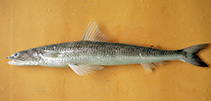
|
Synodus bondi Fowler, 1939 Sharpnose lizardfish |

|
|
photo by
Carvalho Filho, A. |
| Family: | Synodontidae (Lizardfishes), subfamily: Synodontinae | |||
| Max. size: | 27.9 cm SL (male/unsexed) | |||
| Environment: | pelagic-neritic; marine | |||
| Distribution: | Western Central Atlantic: the Carribbean, southern area: Jamaica, Haiti, Belize, Honduras, Panama, Trinidad and Tobago, Brazil, French Guiana, Guyana, and Venezuela. | |||
| Diagnosis: | Dorsal soft rays (total): 11-12; Anal soft rays: 10-12; Vertebrae: 56-60. This species is distinguished by the following set of characters: D 11-12; A 10-12, rarely 12; pectoral-fin n rays 12-14; total caudal-fin rays 42; configuration of the caudal-fin rays always 12 dorsal procurrent caudal rays + 10 segmented dorsal rays + 9 segmented ventral rays + 11 ventral procurrent rays; total vertebrae 56-60, 59 modally; lateral-line scales 57-60, modally 60; predorsal scales 23-25; scales above lateral-line to dorsal-fin base 5.5 or 6.5; head length (HL) 22.4-26.7% SL (25.2%); snout very long and triangular, its length 6.3-9.1% SL, mean 7.3%, and 26.3-37.2% HL, mean 29.0%, and the tip sharply pointed; anterior nostril has a long, narrow flap that tapers to a filament distally, length 2.6-5.3% HL (3.4%); orbit diameter is 2.8-4.9% SL (3.5%) and 11.1-19.0% HL (13.8%); the interorbital width 10.4-16.9% HL (15.5%); presence of thick adipose lids on anterior and ventral margins of orbit (width 3.4-7.4% HL, mean 4.8%); the dorsal-fin base 10.5-13.0% SL, mean 11.9%, and usually longer than anal-fin n base (9.6-12.7% SL, mean 11.0%); colour when alive, body pale green to tan and when preserved, body dark gray to reddish brown above the lateral axis, pale below, few lateral stripes darker than background color sometimes present along length of body, no vertical bars on trunk, there is dark pigmentation on margins of caudal fin, usually extending onto main portion of ventral lobe, the dorsal half of adipose fin dark (Ref. 93218). | |||
| Biology: | ||||
| IUCN Red List Status: | Least Concern (LC); Date assessed: 16 September 2014 Ref. (130435) | |||
| Threat to humans: | harmless | |||